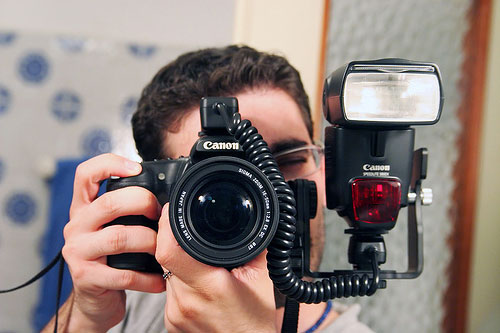Shooting with a flash can be really intimidating if you are new to photography. As if all the variables within your camera weren't enough to remember, throwing a flash in the mix has the potential to really screw up how you think about photography. Shooting with a flash shouldn't be scary or overly-complicated but there are some basic skills that will help you get great results.
1. Flashes on camera's don't illuminate subject matter. OK, they do, but that's now how they actually work. The way flashes work with cameras is the flash will throw light on your subject and the light that bounces back is what your camera records. The further your subject, the more powerful flash you need.
2. Every flash photograph is two exposures. The flash only fires once the shutter opens, during that time ambient light is also recorded. Because the flash is not effected by shutter speed, keeping the shutter open longer will not illuminate your subject any more; it will however cause more ambient light in and open up the possibilities to blurred photos. Flash photography is affected by ISO settings, the higher ISO the more effective your flash becomes at any given distance.
3. Flash illumination efficiency is dramatically affected by distance. At a certain point, your flash simply doesn't have enough power to effectively illuminate and reflect light back to your camera. While you can adjust your ISO (digital shooters) and aperture to help compensate, you simply can't expect your flash to work outside of its working range.
4. Maximum flash sync of 1/200th. All cameras with a shutter box in them, which excludes point and shoots, have a maximum shutter sync speed of 1/200th of a second, with a few exceptions of specific models. This is important to know when you are trying to utilize a specific shutter speed to stop action.
5. Understanding the Guide Number. The guide number for an electronic flash is a way of quantifying its maximum output in terms that a photographer can relate to – aperture and distance. The guide number (GN) is the product of the aperture (f/ stop) and distance (from flash to subject) combination that will result in enough light for proper exposure. Often times the price of a flash is in direct relationship to the guide number; the higher guide number the more illumination at a further distance it will have.
6. Bouncing the flash. Light will reflect and refract off of objects and often times a straight on flash will not give the desired results, especially when shooting people. You can soften the light from the flash by bouncing it, most commonly off a ceiling. Angle your flash head at 45 degrees or off a wall at 45 degrees for a side bounce. When there is no ceiling or wall to bounce off of, a modifier like an Omni-Bounce by Stofen can help diffuse the light and simulate a ceiling.
7. Get the flash off the camera. Moving the flash off the hot shoe by utilizing a flash bracket has two main advantages. When shooting people, moving the flash further away from the lens will near totally eliminate all chances of red-eye. Secondly, most all flash brackets have a pivot point in them, a hinge if you will. This allows them to rotate 90 degrees so the flash stays above the lens when shooting vertically, giving you a more pleasing shadow and voiding the side flash.
Shooting with a flash can be fun and rewarding, but understanding the basics of how they work and when to use them is essential. Like all other gear, reading the manual is the first step in learning how to use your flash best.









17 Comments
Good to know. I have a flash gun and it used to produce much unwanted effects (too dim or too bright). There's a GN on it however I found it hard to follow.
Good tips, I haven't used my flash bracket in years – I'll pull it out and give it a try.
Hi ! Thank you for the DM, and for excellent content !
Good tips… but you've missed a major link here.
To really get an understanding of how flash (particularly off camera flash) works, go to http://www.strobist.com – my pictures improved 300-fold once I'd read the strobist 101 series
just be careful when you stimulate the ceiling……..
Some Nikons have 1/500 (to unlimited) flash sync speed. Also, most modern cameras have high-speed flash sync. So your comment about the 1/200th is not that correct or useful.
Thanks for your constructive feedback.
😉
Agreed – Strobist is such a great website.
Thanks for stopping by Alan.
Flash can be daunting at first, good starting tips here! More info for those that are interested:
Andrew
The Discerning Photographer
Thanks for stopping by Andrew. Great article you wrote there. 🙂
Thanks for the foundational info–I am in that class of new hobby photographer who is deathly afraid of her flash–I do some freelance work and cringe when I am going to do a photography assignment and it’s indoors. I guess I need to add a flash bracket to my list of -to-buy items.
Miachelle,
I’m with you. Sounds like we’re in exactly the same boat!
I’ve got an event coming up and I’m starting to panic.
If you have a flash on the hot shoe, and are going to take a portrait (vertical shot), what would you do to avoid having the side of the subject closest to the flash from being much more highly exposed than the far side?
thanks
Good article, enjoyed reading it.
This is stuff that most wedding photographers should know as a basic but unfortunately don’t, good read and covers pretty much what is explained in the zach arias one light dvd which is well worth getting for anyone getting into flash lighting 🙂